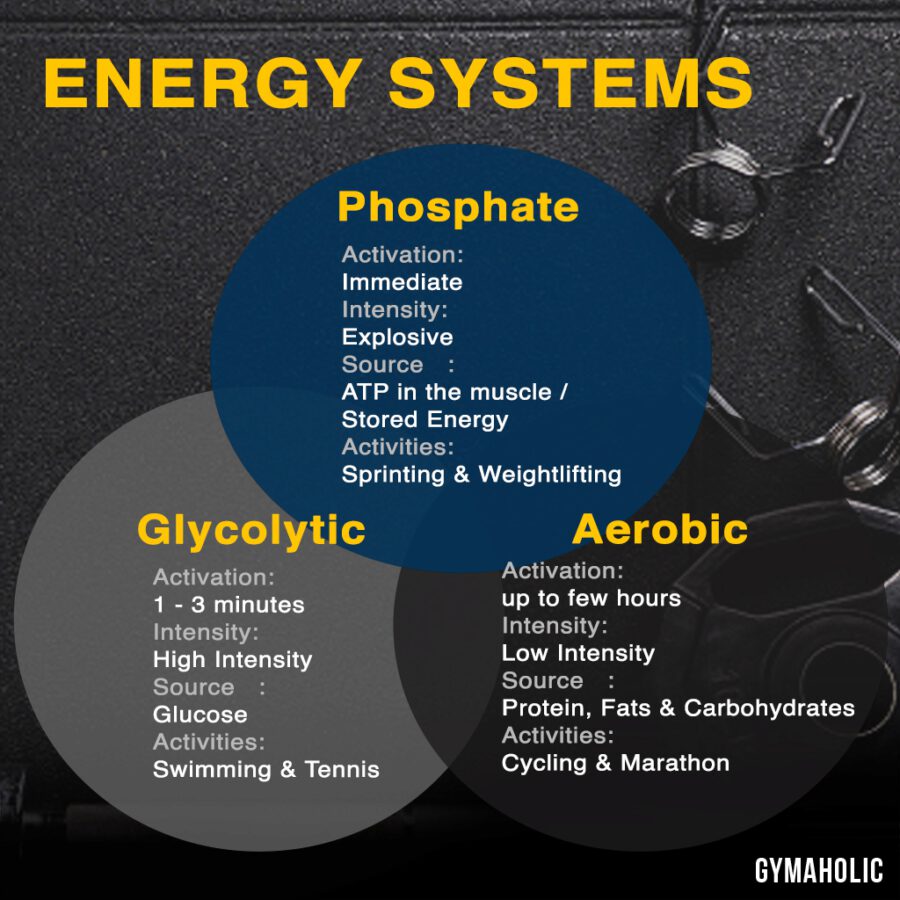Understanding Energy Systems
On a simple note, energy is the ability to do work, but have you ever wondered where you get your energy from?
How can you accomplish a highly demanding task such as working out or simply climbing a couple of stairs?
For most of us, we only think about these questions when we “ran out of gas” during sports activities or intense exercise sessions.
In reality, our body is constantly using different energy systems all day long – shifting and alternating energy modes as you create demands on your body.
In fact, you can train your body to become efficient in using your energy and produce a stable energy output during your activities.
The better you are at using your energy, the more work you’ll be able to do, and the longer you’ll be able to do it.
The more energy you have, the less likely you fatigue and be able to recover quickly.
In this article we will explain the different energy systems and how to train accordingly.
Energy systems refer to complex processes of producing energy for your body to use for various physical activities.
Although these systems are all active during all forms of activity, they have different functions depending on the intensity and amount of the work you perform.
Training with these systems in mind can help you achieve tremendous changes in your body.
For example, the phosphagen and glycolytic energy systems will help you build muscles by utilizing proteins as energy source and activating the fast twitch muscle fibers.
Quick and intense workout activities such as in HIIT training will also utilize the phosphagen system that results to “after burn effect”, a phenomenon which causes your body to burn calories even hours after working out.
Imagine how powerful it is to burn fats in the shortest amount of time.
This system activates during explosive activities such as plyometric exercises.
These are sharp bursts of energy that last only for about 6-12 seconds.
Since your body needs immediate source of energy during high intensity and early acceleration, it relies on stored energy within your muscles called ATP-AC (Adenosine Triphosphate – Creatine Phosphate)
Doing so will prolong your ability to maintain higher intensity workouts or physical activity.
This is crucial for elite athletes who rely heavily on burst amounts of energy.
Activities that rely on Phosphagen System:
- High Jumps
- Sprints
- Weight Lifting (Barbell Snatch)
- Volleyball
- Long Jumps
You can train the phosphagen system by doing explosive strength and power exercises.
After exhausting the initial ATPs in your muscle, your body transition to a glycolytic energy source to sustain moderate to high-intensity bursts of activity.
This system is fueled by stored glucose in your muscle and lasts for about 1 to 3 minutes.
As a result of activating the glycolytic system for a more extended capacity, waste byproducts are produced like lactic acid, which accumulates in your muscles and bloodstream.
This leads to the “familiar” burning sensation and fatigue you feel when doing high-rep exercises.
Improving this system during your training can reduce the amount of lactic acid that builds up in your muscle and sustain your ability to tap this energy system, resulting in higher intensity and better performance.
Activities that rely on Glycolytic System:
- Basketball
- Tennis
- Volleyball
- BMX events
- Acrobatic Gymnastics
Athletes who rely on high intensity - prolonged energy use the glycolytic system.
It relies on the constant flow of oxygen from our circulatory system, and it uses proteins, carbs, and fats to produce energy slowly.
The aerobic energy system is the slowest to activate among the three systems.
Still, it is essentially the primary energy source needed for prolonged movements and endurance sports.
Training your body to use the aerobic energy system efficiently will enhance oxygen utilization and allow you to sustain activities longer before fatiguing and cramping out.
Activities that rely on aerobic system:
- Hiking
- Long Distance Running / marathon
- Cycling
- Cross-country Skiing
- Rowing
When you engage in low to medium-intensity activities that challenge your endurance, you tap into the Aerobic Energy System. This system activates gradually and provides you energy for up to a few hours.
In reality, these systems does not work exclusively but rather simultaneously interacting with each other and providing you the energy you need to function on a higher level as possible.So, an overall balanced training would be equally beneficial without neglecting other aspects of your fitness level.
It is essential to know where your energy comes from and how you can use these systems to your advantage.After all, knowledge is power, and those who have power, yields better performance and results.
- Kraemer WJ, Fleck, SJ, Deschenes MR (2021) Exercise Physiology: Interating Theory and Application. Philadelphia: Wolters Kluwer/Lippincott Williams and Wikins
- Brooks G, Fahey Baldwin (2005) Exercise Physiology: Human Biogenergetics and Its Application
- Cifu, D. and Eapen, B., 2018. Braddom's physical medicine and rehabilitation.
- Baker, J.S (2010). Interaction among Skeletal Muscle Metabolic Energy Systems during Intense Exercise. Journal of Nutrition and Metabolism 2010 1-13

